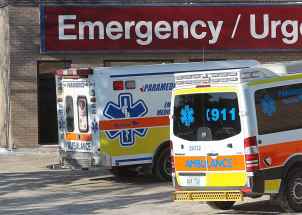HSC, St. B ambulance redirections climb in 2019
Read this article for free:
or
Already have an account? Log in here »
To continue reading, please subscribe:
Monthly Digital Subscription
$0 for the first 4 weeks*
- Enjoy unlimited reading on winnipegfreepress.com
- Read the E-Edition, our digital replica newspaper
- Access News Break, our award-winning app
- Play interactive puzzles
*No charge for 4 weeks then price increases to the regular rate of $19.00 plus GST every four weeks. Offer available to new and qualified returning subscribers only. Cancel any time.
Monthly Digital Subscription
$4.75/week*
- Enjoy unlimited reading on winnipegfreepress.com
- Read the E-Edition, our digital replica newspaper
- Access News Break, our award-winning app
- Play interactive puzzles
*Billed as $19 plus GST every four weeks. Cancel any time.
To continue reading, please subscribe:
Add Free Press access to your Brandon Sun subscription for only an additional
$1 for the first 4 weeks*
*Your next subscription payment will increase by $1.00 and you will be charged $16.99 plus GST for four weeks. After four weeks, your payment will increase to $23.99 plus GST every four weeks.
Read unlimited articles for free today:
or
Already have an account? Log in here »
Hey there, time traveller!
This article was published 06/11/2019 (2230 days ago), so information in it may no longer be current.
Winnipeg’s two largest hospitals have had to redirect ambulances away from their emergency rooms more frequently in 2019 than in any of the previous four years.
Through the end of September, Health Sciences Centre had diverted ambulances 1,242 times, while St. Boniface Hospital had done so 300 times, according to data compiled by the Manitoba Nurses Union, based on a freedom of information request.
The HSC number exceeds full-year totals for all but one year (1,292 in 2016) since 2015, while the St. Boniface total, through nine months, far exceeds that for any recent year.

!function(e,i,n,s){var t=”InfogramEmbeds”,d=e.getElementsByTagName(“script”)[0];if(window[t]&&window[t].initialized)window[t].process&&window[t].process();else if(!e.getElementById(n)){var o=e.createElement(“script”);o.async=1,o.id=n,o.src=”https://e.infogram.com/js/dist/embed-loader-min.js”,d.parentNode.insertBefore(o,d)}}(document,0,”infogram-async”);
The rising total of ambulance redirects at the two big hospitals comes as the number of ERs in Winnipeg has shrunk to three from six in 2017. Grace Hospital is the other remaining city facility with both an ER and an intensive care unit.
Darlene Jackson, MNU president, said she is not surprised by the figures.
"This is exactly what nurses have been talking about. They’ve been talking about the lack of capacity in the system," she said Wednesday. "It’s worrying for patient care. I think it’s worrying for patient safety."
Sources say intensive care units in all three city hospitals with emergency rooms are at or exceeding capacity almost every day — with flu season yet to begin.
In September, St. Boniface requested ambulances be redirected from its ER on 90 occasions. That’s more than half the number of diversions the hospital usually records in a 12-month period.

!function(e,i,n,s){var t=”InfogramEmbeds”,d=e.getElementsByTagName(“script”)[0];if(window[t]&&window[t].initialized)window[t].process&&window[t].process();else if(!e.getElementById(n)){var o=e.createElement(“script”);o.async=1,o.id=n,o.src=”https://e.infogram.com/js/dist/embed-loader-min.js”,d.parentNode.insertBefore(o,d)}}(document,0,”infogram-async”);
The Winnipeg Regional Health Authority declined to make someone available for an interview Wednesday. Instead, it sent a lengthy statement, attributed to Krista Williams, chief nursing officer and chief health operations officer.
Williams said the "exact driving forces behind the increase" in ambulance redirects are still being examined.
"Our preliminary data for the month of October indicates significant improvement with respect to ambulance redirections when compared with previous months," she said.
Ambulance destination protocols, established to balance work within the system, were refined in early October to reflect the newly reorganized Winnipeg hospital system, Williams said.
"System performance is closely monitored, and when an upturn in redirections was identified, action was taken. The refined protocols were introduced partly in response to that observed increase."
She said the WRHA believes the updated ambulance protocols are having the intended effect.
Brianne Goertzen, provincial director of the Manitoba Health Coalition, a group dedicated to preserving and expanding universal public health care, said the numbers obtained by the Free Press are "quite startling."
“I think we’ve all heard about capacity issues, especially from our front-line workers,” she said.
Goertzen said rising ambulance redirections are indicative of a system with fewer emergency rooms, less system capacity and a shortage of staff. She noted they are occurring as ER wait times in Winnipeg are climbing.
“System performance is closely monitored, and when an upturn in redirections was identified, action was taken. The refined protocols were introduced partly in response to that observed increase.” – Krista Williams, chief nursing officer and chief health operations officer
Meanwhile, Williams said when a hospital experiences a surge in demand, it may request ambulances be temporarily redirected to another site.
Every effort is made to minimize the frequency of these redirections, she said.
"It’s important to note that during redirection periods, all patients who need (an ambulance) will be transported to an emergency department or urgent care centre for care. No patients are ‘turned away’ — they are simply brought to a different hospital within the city," Williams said.
larry.kusch@freepress.mb.ca

Our newsroom depends on a growing audience of readers to power our journalism. If you are not a paid reader, please consider becoming a subscriber.
Our newsroom depends on its audience of readers to power our journalism. Thank you for your support.
History
Updated on Wednesday, November 6, 2019 7:06 PM CST: Removed the factbox.










